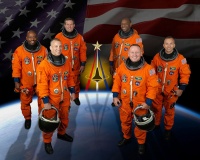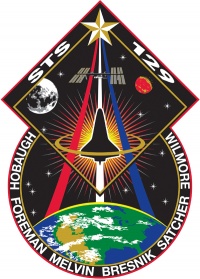STS-129
From The Space Library
 | |
| Organization | NASA-SpaceOperationsMissionDirectorate(UnitedStates) |
|---|---|
| Mission type | Human Crew,Resupply/Refurbishment/Repair |
| Launch date | November 16, 2009 |
| Launch vehicle | Space Shuttle |
| Launch site | Cape Canaveral, United States |
| COSPAR ID | 2009-062A |
| Inclination | 51.6 degrees |
| Experiments | Here |
| Alternate Names | 36094 |
| Additional Information | Here |
| Data Collection | Here |
| Payload Mass Up | 13322.91 kg |
| Payload Mass Down | 1333.18 kg |
| Orbiter | Atlantis |
| Lift Off Mass | 2,055,576.82 kg |
| Orbiter Weight at Liftoff | 121,050.00 kg |
| Orbiter Weight at Landing | 93,372.73 kg |
| Landed | 9:45 a.m. EST, concrete runway 33, Kennedy Space Center, Fla. |
| Orbits of Earth | 171 |
| Orbital Altitude | 191 nautical miles |
Contents |
[edit] Crew
- Commander: Charles O. Hobaugh
- Pilot: Barry E. Wilmore
- Payload Commander:
- Mission Specialist 1: Randolph J. Bresnik
- Mission Specialist 2: Michael J. Foreman
- Mission Specialist 3: Leland D. Melvin
- Mission Specialist 4: Robert L. Satcher Jr.
- Mission Specialist 5:
- Payload Specialist 1:
- Payload Specialist 2:
ISS/Mir Crew Transport
- Nicole P. Stott - down only
[edit] Mission
STS 129 was an American shuttle craft carrying six astronauts and 12.36 tonnes of supplies for the International Space Station. It launched from Cape Canaveral on 16 November 2009 at 19:28 UT. The craft docked with the International Space Station at 16:51 UT on 18 November 2009. The cargo included mostly spare parts for the ISS, much of which were mounted on the exterior of the ISS on two Express Logistics Carriers (ELC 1 and 2). The mission included three spacewalks and the return of one of the ISS crew members. The STS 129 mission completed with a landing at Cape Canaveral on 27 November 2009 at 14:45 UT.
[edit] EVA
Extravehicular Activity (EVA) conducted by Mike Foreman, Robert Satcher, and Randy Bresnik during three spacewalks for a total of 18 hours, 27 minutes. Leland Melvin and Randy Bresnik removed ELC1 from Atlantis's payload bay using the shuttle's robotic arm and handed it off to the station's robotic arm controlled by Barry Wilmore and ISS crew member Jeff Williams, who installed the carrier on the ISS P3 truss. ELC2 was installed on the ISS S3 truss using the station's robotic arm operated by Melvin and Nicole Stott. EVA 1, 6 hours, 37 minutes; Foreman and Satcher installed a spare S-band antenna assembly on the ISS Z1 truss, installed antenna cables on Destiny, replaced a handrail on Unity, and installed a Payload Attach System (PAS) on the Earth-facing side of the S3 truss. EVA 2, 6 hours, 8 minutes; Foreman and Bresnik installed the Grappling Adaptor to On-orbit Railing Assembly (GATOR) on a Columbus handrail, relocated the station's floating potential measurement unit to the P1 truss, installed a second PAS on the upper part of the S3 truss, deployed a third PAS on the S3 truss, and installed a wireless video system on S3. EVA 3, 5 hours, 42 minutes; Satcher and Bresnik installed a high-pressure oxygen tank that had been stored on ELC2 and subsequently placed by the Quest airlock by Melvin and Wilmore using the ISS robotic arm. Satcher and Bresnik also installed MISSE 7 on ELC2.
[edit] Payload
ISS Assembly Flight ULF3; deliver and integrate ExPRESS Logistics Carrier 1 and 2 (ELC1 and ELC2) carrying numerous orbital replacement units too big and massive to fly in any of the vehicles that will be left when the space shuttle retires, such as control moment gyroscopes, a battery charge discharge unit, a plasma contactor unit, nitrogen tanks, cooling system pump module assemblies, high-pressure gas tanks, ammonia tanks, a latching end effector for the station's robotics, and a trailing umbilical system reel assembly; Materials International Space Station Experiment (MISSE) 7; return ISS crew member Nicole Stott to Earth
[edit] Books about the Space Shuttle Program
Buy This Book Click here |
Buy This Book here |
Buy This Book Click here |
Buy This Book Click here |





